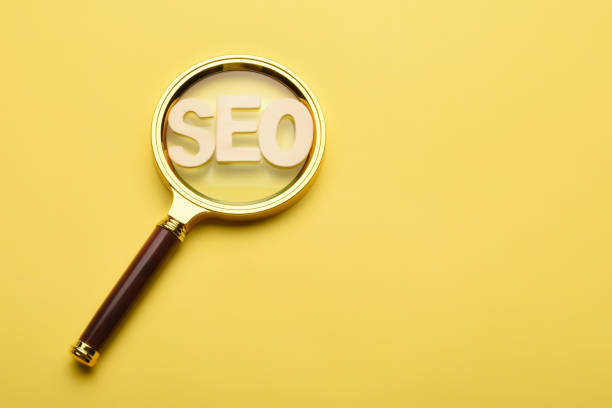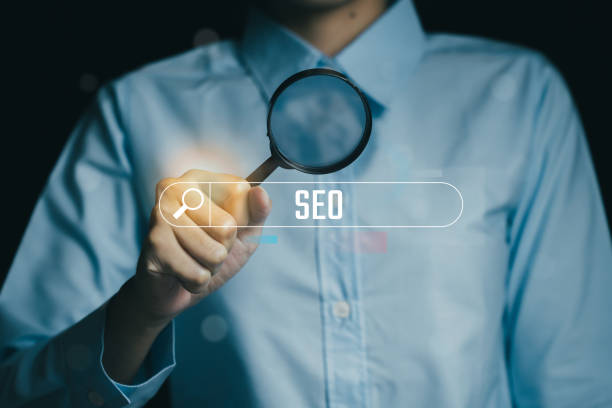Introduction to SEO and its Importance in Today’s World

In the current digital age, an online presence is vital for every business and individual.
But simply having a website is not enough; you must ensure your target audience can find it.
This is where the concept of #SEO or #Search_Engine_Optimization comes in.
SEO is a set of techniques and strategies aimed at improving your website’s ranking in search engine results like Google, Bing, and Yahoo.
When a user searches for a term, search engines examine millions of pages and display the most relevant and high-quality results.
The main goal of SEO is to place your website among these top results.
This process goes beyond merely placing keywords and includes technical, content, and credibility aspects.
The importance of digital SEO in today’s world is undeniable.
Most internet users start their search through search engines and tend to click on the first results.
In fact, the first pages of search results receive the most clicks, and if your website is on later pages, its visibility significantly decreases.
Therefore, a smart content SEO strategy can drive organic and targeted traffic to your website, which means real visitors looking for your products or services.
This high-quality traffic leads to increased brand awareness, improved conversion rates, and ultimately, sustainable business growth.
Understanding the basics of SEO is a necessity for anyone looking for online success.
Did you know 94% of users’ first impression of a business is related to its website design? With professional corporate website design by **Rasawweb**, turn this first impression into an opportunity for growth.
✅ Attract more customers and increase sales
✅ Build credibility and trust in the audience’s eyes⚡ Get free website design consultation!
Types of SEO and Their Key Differences

SEO is a broad field that can be divided into three main categories: #On-Page_SEO, #Off-Page_SEO, and #Technical_SEO.
Each of these sections focuses on different aspects of your website, and their mutual cooperation is essential for achieving desired results.
On-page SEO refers to all actions performed within your website to improve its ranking.
This includes content optimization, keyword usage, optimizing title tags and meta descriptions, URL structure, using Heading tags, and image optimization.
The goal of on-page SEO is for search engines and users to easily understand your content and recognize its value.
A comprehensive approach to SEO design on-page is very important.
In contrast, off-page SEO deals with all activities performed outside your website, aiming to increase the website’s authority and trust.
The most important element in off-page SEO is #Link_Building.
Receiving backlinks from reputable and relevant websites indicates to search engines that your content is valuable and trustworthy.
Besides link building, activity on social networks, influencer marketing, and content publishing on other platforms can also help improve off-page SEO.
Technical SEO also focuses on the technical aspects of the website to ensure that search engines can easily crawl and index your website.
This includes site loading speed, mobile compatibility, URL structure, using sitemaps, robots.txt files, and website security (HTTPS).
In fact, advanced SEO techniques often relate to technical SEO to maximize user experience and site accessibility.
These three sections together form a comprehensive and effective strategy for website SEO optimization.
Keyword Research: The Cornerstone of Successful SEO

One of the first and most important steps in any #strong_SEO strategy is #keyword_research.
Keywords are phrases that users enter into search engines to find desired information, products, or services.
Identifying the right keywords helps you create content that precisely matches the needs and questions of your audience.
This process goes beyond guesswork and requires data analysis and the use of specialized tools.
You should examine keywords in terms of search volume (monthly search amount), difficulty (level of competition to rank for that keyword), and relevance to your business.
Keywords with high search volume and low difficulty are ideal but difficult to find.
Therefore, a combination of keywords with medium competition and also longer keywords (Long-tail Keywords) that have lower search volume but a clearer intent is recommended.
For keyword research, various tools such as Google Keyword Planner, Ahrefs, SEMrush, and KWFinder are available that can help you discover new keywords, analyze competitors, and review important metrics.
Remember that keywords are not just for text content; they should also be used in title tags, meta descriptions, URLs, and even image names.
Content SEO principles are based on this precise keyword research.
Choosing the right keywords allows you to produce specialized and valuable content that is not only ranked by search engines but also truly answers your users’ needs.
This initial step ensures that all your subsequent efforts in keyword research are built on a solid, data-driven foundation.
Below is a table of keyword types and their characteristics:
| Keyword Type | Description | Example |
|---|---|---|
| Short-tail Keywords | One to two words, high search volume, high competition, unclear intent. | “shoes”, “marketing” |
| Mid-tail Keywords | Two to three words, medium volume and competition, slightly clearer intent. | “men’s sports shoes”, “digital marketing” |
| Long-tail Keywords | Three or more words, lower search volume, low competition, clear intent. | “best men’s sports shoes for running”, “free digital marketing training course” |
| Semantic Keywords | Phrases related to the main keyword that complete its meaning. | For “coffee”: “coffee shop”, “espresso”, “coffee beans” |
On-Page SEO Optimization for Effective Content

On-page SEO is the backbone of any #strong_and_sustainable_SEO strategy.
This section focuses on all elements directly on your website pages that are controllable by you.
It starts with the #Title_Tag, which is the first thing users see in search results and should include the main keyword and be attractive.
The Meta Description tag, although not directly affecting ranking, can increase the click-through rate (CTR) as it provides an attractive summary of the page’s content.
Smart use of keywords throughout the text, in a way that is natural and readable, is very important.
Keyword Stuffing not only does not help your SEO but can also be penalized by search engines.
This is where producing educational and high-quality content becomes important.
Content structure also plays a vital role.
Using Heading tags (H1, H2, H3, etc.) to organize text and highlight important sections helps both readability for users and assists search engines in understanding your content structure.
H1 should be used for the main page title and include the main keyword.
Image optimization, including using descriptive file names, appropriate Alt tags (which include the keyword), and compressing images to improve site loading speed, are other important aspects of on-page SEO.
Furthermore, using Internal Links that connect related pages on your website not only helps users with navigation but also distributes page authority throughout the site.
This set of actions covers influential SEO factors on ranking and user experience and should be considered independently for each page to maximize SEO optimization.
Do you have an e-commerce site, but your sales are not as expected? Rasawweb solves your problem forever with professional e-commerce website design!
✅ Significant increase in conversion rates and sales
✅ Exceptional user experience for your customers⚡ Click to get free online store design consultation!
The Importance of Targeted Content Production for SEO

Content is king, and this phrase never gets old in the world of #smart_SEO.
Producing high-quality and targeted content not only attracts users but also encourages search engines to rank your website higher.
Content should answer users’ needs and questions and provide accurate, comprehensive, and useful information.
Various types of content can help your SEO strategy, including #explanatory and #guidance articles, #news blog posts, #question-provoking content that generates interaction, and even #entertaining content that can help increase user dwell time on your site.
Each type of content must be accompanied by precise keyword research to ensure it addresses the audience’s real needs.
In addition to quality, content freshness is also important.
Regularly updating old content and publishing new content shows search engines that your website is active and dynamic.
Also, using visual elements such as images, infographics, and videos can increase the attractiveness of your content and make it more appealing to users and search engines.
One of the key aspects of content production for effective SEO is creating question-provoking content that encourages users to discuss and exchange opinions.
This type of content can include open-ended questions, surveys, or controversial topics that lead to increased interaction and social sharing.
Analytical content is also very valuable for specialized audiences and can establish your website as a credible reference in your field.
A comprehensive approach to content production for SEO will lead to higher rankings and targeted traffic.
The Importance of Link Building (Off-Page SEO) and Gaining Authority

Link building is one of the most important and challenging aspects of #off-page_SEO.
Search engines treat incoming links (backlinks) as a vote of confidence from other websites.
The more numerous and higher quality the backlinks pointing to your site, the more credible and trustworthy search engines will consider your site, which helps improve your ranking.
However, not every link is valuable; links from reputable, relevant, and high-authority websites have much greater value.
For example, a link from a reputable news site or a university is much more powerful than a link from an unknown website.
This is where business SEO improvement through smart link building becomes important.
There are various methods for link building, including creating valuable and shareable content (which naturally attracts links), Broken Link Building (which involves finding broken links on other sites and offering your content as a replacement), and social media engagement.
Guest Posting (writing articles for other blogs) and publishing content on reputable directories are also common methods.
It is important to avoid spammy and low-quality link building, as this will not only not help your ranking but can also lead to penalties by Google.
Therefore, focusing on quality over quantity in link building is crucial.
This process is time-consuming and requires patience and persistence, but its results are invaluable for the sustainable SEO success of your website.
Understanding the importance of link building in SEO is the key to unlocking your site’s full potential in search results.
Technical SEO and Its Role in User Experience

Technical SEO is a crucial part of #comprehensive_SEO that ensures your website is technically ready for crawling and indexing by search engines.
This aspect of SEO often happens behind the scenes but has a direct impact on user experience and, ultimately, your ranking.
Site loading speed is one of the most important technical factors.
Today’s users expect websites to load quickly, and if your site is slow, they are likely to leave it.
Google also prefers fast sites.
Image optimization, caching, code compression, and choosing appropriate hosting are among the ways to increase site speed.
Furthermore, Mobile-Friendliness is of paramount importance, as most searches today are conducted via mobile devices.
A responsive design that displays well on all devices is essential.
Website security is also an important ranking factor; using the HTTPS protocol (displayed with a lock next to the URL in the browser) to encrypt communications builds trust with users and search engines.
URL structure, using robots.txt files to guide search robots on which pages to crawl, and sitemaps (sitemap.xml) that introduce all important pages of your website to search engines are other vital elements in technical SEO.
These actions ensure that your website is optimized not only for users but also for search engine bots, which greatly assists modern SEO strategies.
Understanding these technical principles is essential for anyone looking to optimize technical SEO.
Below is a table for reviewing important technical factors:
| Technical Factor | Description | Importance |
|---|---|---|
| Site Loading Speed | The time required for a page’s content to fully load. | Very High (Direct impact on UX and ranking). |
| Mobile Compatibility | How the site is displayed on mobile devices. | Very High (Google’s priority for Mobile-First Indexing). |
| Use of HTTPS | Secure protocol for encrypted communications. | High (Ranking factor and user trust). |
| XML Sitemap | A file that specifies the site structure for search engines. | Medium (Helps with better crawling). |
| Robots.txt | A file to control robot access to parts of the site. | Medium (Prevents crawling of unimportant pages). |
| Clean and Structured Code | How the website is coded for easy understanding by search engines. | High (Impact on crawlability and indexing). |
Measuring SEO Success and Analytics Tools

After implementing #optimized_SEO strategies, measuring and analyzing results is essential to understand the effectiveness of your efforts.
Without data, you cannot know what is working and what needs improvement.
Analytical tools are available to help you monitor your website’s performance in search results.
#Google_Analytics is one of the most powerful and free tools that provides comprehensive and accurate information about your website traffic, including the number of visitors, pages visited, time spent on site, Bounce Rate, and traffic source.
Using this data, you can understand user behavior and optimize your content to better meet their needs.
These analyses help us with comprehensive SEO knowledge.
#Google_Search_Console (GSC) is another vital tool provided directly by Google that offers deep insights into how your website interacts with the search engine.
GSC shows you what keywords your site has ranked for, how many clicks and impressions you have received, and identifies technical issues on the site (such as crawl errors or mobile problems).
This tool allows you to track keyword performance, top-performing pages, and even indexing issues.
Additionally, paid tools like Ahrefs and SEMrush offer more advanced features such as competitor analysis, backlink checking, and keyword suggestions, which are very useful for a deeper analysis of your business SEO status.
By regularly monitoring these metrics and tools, you can continuously improve your SEO strategy and ensure you are on the right track to achieving your online goals.
Analyzing SEO data is a continuous process that requires constant attention and learning.
Is your current e-commerce website design not generating the sales you expect?
Rasawweb specializes in professional e-commerce website design!
✅ Attractive and user-friendly site aimed at increasing sales
✅ High speed and security for an ideal shopping experience⚡ Get free online store design consultation with Rasawweb!
New Trends and the Future of SEO

The world of #SEO_is_always_evolving, and search engine algorithms are constantly being updated.
To maintain ranking and traffic, it is important to stay aware of the latest trends and advancements.
One of the most important recent trends is the increased emphasis on #User_Experience (UX).
Google and other search engines prefer sites that offer a better user experience.
This includes site speed, mobile compatibility, attractive visual design, easy navigation, and high-quality content.
Core Web Vitals, a set of metrics related to web page loading speed, interactivity, and visual stability, is an example of this new emphasis.
Therefore, improving user experience should be at the heart of any sustainable SEO strategy.
Voice Search has also become increasingly popular.
With the proliferation of voice assistants like Siri and Google Assistant, users ask their questions verbally instead of typing.
This affects how keywords are chosen and content is structured; content should be written to answer natural and conversational questions.
Artificial Intelligence (AI) and machine learning also play a significant role in the future of modern SEO.
Algorithms like RankBrain and BERT use AI to better understand user intent and provide more accurate results.
This means that merely stuffing text with keywords is no longer enough; content must be semantically rich and conceptually relevant.
Video SEO, Local SEO, and the increasing importance of E-A-T (Expertise, Authoritativeness, Trustworthiness) are other important trends.
Given these changes, your smart SEO strategy must be flexible and constantly adapt to new trends to stay ahead of the competition.
Facing SEO trends is a challenge but an opportunity for growth.
Common SEO Mistakes and Ways to Prevent Them

On the path to #successful_SEO, there are common mistakes that can seriously harm your website’s ranking.
Identifying and preventing these mistakes is crucial for a #comprehensive_and_effective_SEO strategy.
One of the biggest mistakes is #Keyword_Stuffing.
Excessive and unnatural use of keywords in the text not only worsens the user experience but can also be identified as spam by search engines and lead to your website being penalized.
Always remember to write content for users, not just for search engines.
Using Duplicate Content is also a big mistake.
Search engines do not like duplicate content and may give your website a lower ranking or even remove it from results.
Ignoring #technical_SEO can also have irreversible consequences.
If your website is slow, not mobile-compatible, or has crawl errors, even the best content cannot achieve a high ranking.
Failure to regularly update content and not adding new content makes your website appear stagnant to search engines.
SEO is an ongoing process and requires continuous attention.
Also, neglecting user experience (UX) will harm your SEO over time, as search engines are increasingly focused on user satisfaction.
Another mistake is rushing to see results.
SEO results take time, usually a few months for your efforts to bear fruit.
Low-quality link building or buying links are also prohibited practices that lead to severe penalties.
By being aware of these mistakes and avoiding them, you can have a smoother and more successful path in your SEO optimization.
Frequently Asked Questions
| Question | Answer |
|---|---|
| What is SEO? | SEO, or Search Engine Optimization, is the process of increasing the quality and quantity of website traffic by improving the site’s ranking in organic search results of search engines like Google. |
| What are the main types of SEO? | SEO is divided into three main categories: On-Page SEO, Off-Page SEO, and Technical SEO. |
| What does On-Page SEO include? | On-Page SEO includes optimizing elements within the website, such as keywords, page titles (Title Tag), meta descriptions (Meta Description), content, URL structure, images, and internal links. |
| What is Off-Page SEO? | Off-Page SEO refers to activities outside the website that help improve its ranking, such as backlink building, social media marketing, and brand mentions. |
| What is Technical SEO? | Technical SEO involves optimizing the technical aspects of a website to help search engines crawl and index it better. This includes site speed, mobile-friendliness, site structure, Sitemaps, and Robots.txt files. |
| What role do Keywords play in SEO? | Keywords are phrases that users enter into search engines. Proper and targeted use of relevant keywords in content and site elements helps search engines understand the topic of your page and display it for relevant searches. |
| What is a Backlink and why is it important? | A backlink, or inbound link, is a link from one website to another. Backlinks act as a “vote of confidence” from other sites for search engines and play a crucial role in the site’s credibility and ranking increase, especially if they are from reputable sites. |
| What impact does quality content have on SEO? | Quality, relevant, comprehensive, and unique content not only attracts and retains users but also shows search engines that your page is valuable. This helps improve rankings, reduce bounce rates, and increase user time on site. |
| Why is site loading speed important for SEO? | Site loading speed is an important ranking factor for Google. Faster sites provide a better user experience, have lower bounce rates, and are preferred by search engines. |
| Is SEO a one-time process? | No, SEO is a continuous and long-term process. Search engine algorithms are constantly changing, competition is increasing, and site content also needs updating. Therefore, SEO requires continuous monitoring, analysis, and optimization. |
And other services of Rasa Web Advertising Agency in the field of advertising
Smart UI/UX: A fast and efficient solution for online growth with a focus on SEO-driven content strategy.
Smart Marketing Automation: A fast and efficient solution for analyzing customer behavior with a focus on Google advertising management.
Smart Reportage: A fast and efficient solution for increasing site traffic with a focus on custom programming.
Smart UI/UX: Professional optimization for user interaction using user experience customization.
Smart Custom Software: A new service for increasing customer acquisition through the use of real data.
And over hundreds of other services in the field of internet advertising, advertising consultation, and organizational solutions
Internet Advertising | Advertising Strategy | Advertorials
Resources
Comprehensive SEO Guide
SEO Optimization
SEO Training
WordPress SEO Guide
?Rasawweb Afarin Digital Marketing Agency is your companion on the path to reaching the peaks of digital success. We transform your business with services such as website design with a modern user interface, professional SEO, social media management, and content marketing.
📍 Tehran, Mirdamad Street, next to Bank Markazi, Southern Kazeroun Alley, Ramin Alley No. 6


